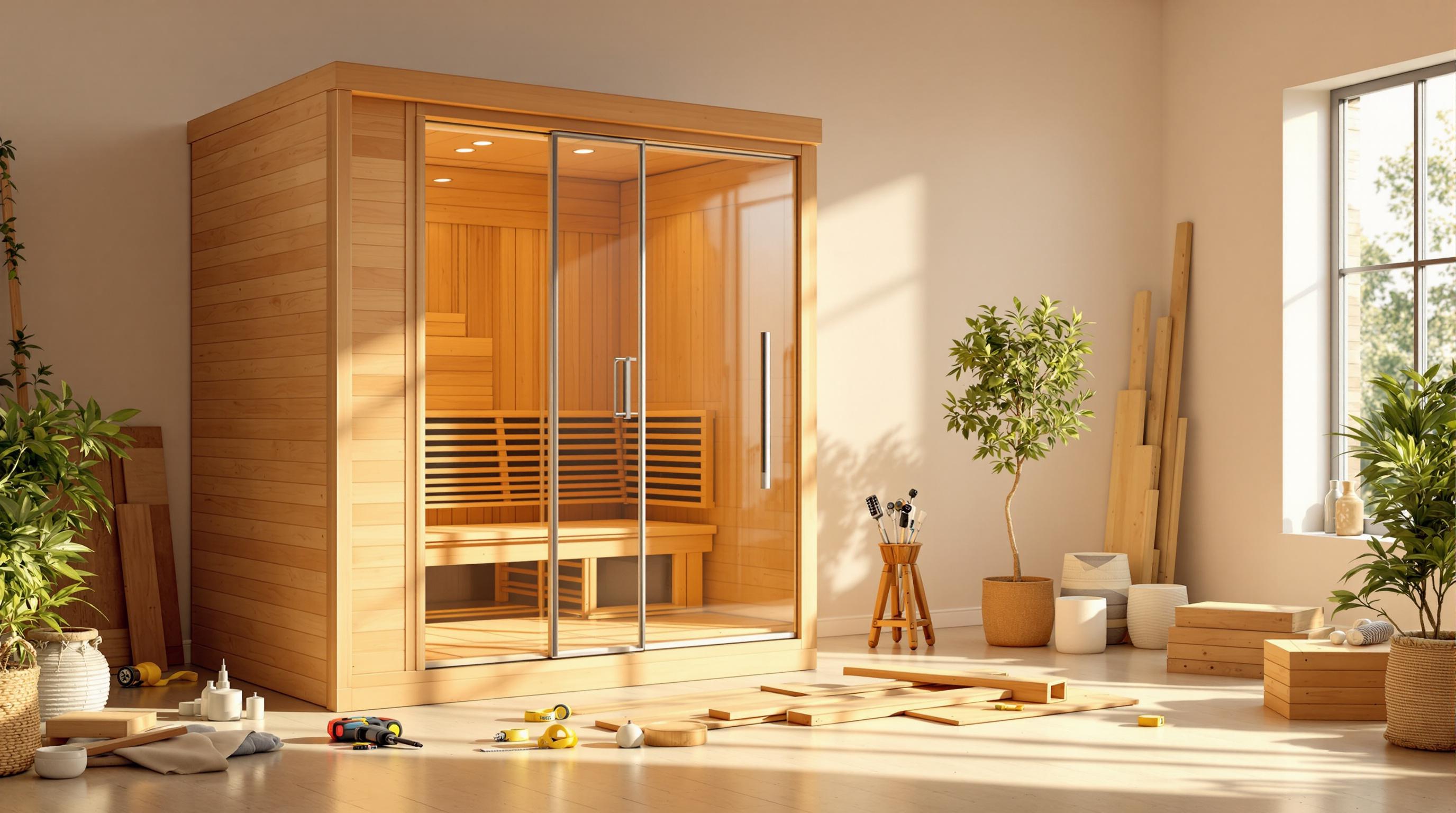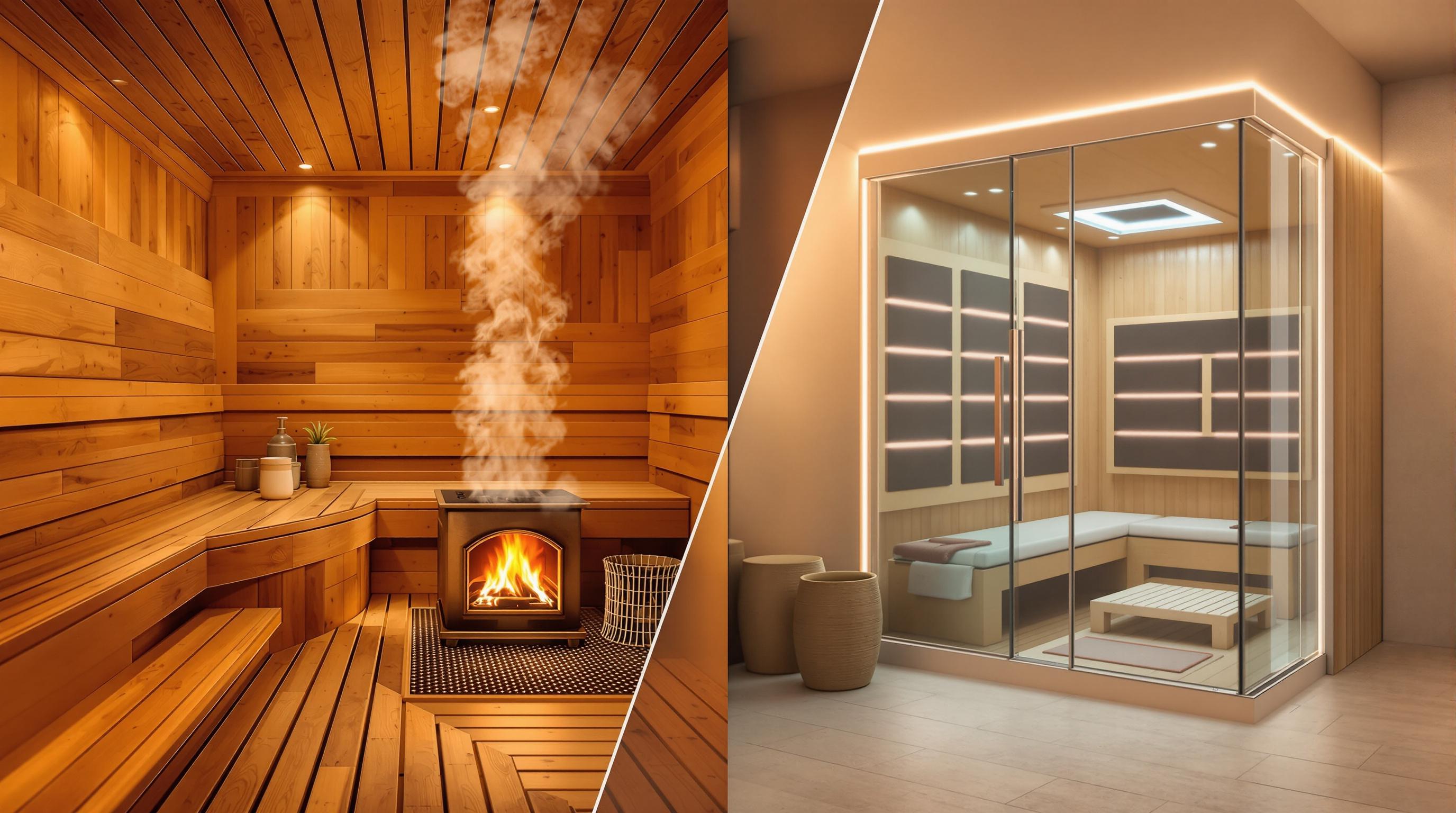Looking to add a sauna to your home? Here's what you need to know about costs in 2025. The price depends on the type of sauna, installation needs, and ongoing maintenance. Here's a quick breakdown:
- Infrared Saunas: Cost $1,000–$10,000. Easy to install (plug-and-play) and energy-efficient with minimal maintenance.
- Steam Saunas: Cost $1,000–$10,000. Require professional installation due to plumbing and ventilation needs. Moisture maintenance is key.
- Hot Rock Saunas: Cost $3,000–$15,000 plus $2,000–$5,000 for installation. Offer a high-heat experience but need more energy and upkeep.
Key Takeaway: Infrared saunas are budget-friendly and simple to set up. Steam saunas provide a humid environment but need careful maintenance. Hot rock saunas deliver a high-heat experience but come with higher costs and upkeep. Choose based on your budget, space, and desired sauna experience.
Cost Comparison Between Steam/Hot Rock & Infrared Saunas
1. Infrared Sauna
Infrared saunas provide a convenient and energy-conscious way to enjoy wellness benefits at home. Instead of heating the air around you, these saunas use infrared panels to warm your body directly.
Purchase Costs
Infrared saunas come in a wide price range, from about $1,000 to $10,000, as noted by Find the Home Sauna of Your Dreams. This range includes options for both individual and family-sized models, catering to different needs and budgets.
Installation
Most infrared saunas are designed to be plug-and-play, meaning they can connect directly to standard electrical outlets. This simple setup makes installation much easier and less costly compared to other types of saunas that often require more complex electrical or structural work.
Operating and Maintenance
These saunas are known for being cost-effective to run. They heat up quickly and use energy efficiently, which helps keep utility bills manageable. Maintenance is also minimal, making them a hassle-free option for homeowners looking for a low-maintenance wellness solution.
Key Features and Benefits
Infrared saunas often include full-spectrum infrared technology, which is praised for its therapeutic effects. Many models also feature user-friendly LED lighting and a compact design, making them easy to fit into most homes while enhancing the overall relaxation experience.
2. Steam Sauna
Steam saunas offer a timeless way to unwind, combining heated rocks and water to create a steamy, humid environment that’s perfect for relaxation.
Pricing and Key Features
As noted by Find the Home Sauna of Your Dreams, steam saunas typically range in price from $1,000 to $10,000, depending on the model and features. Many units include thoughtful touches like built-in benches for comfort, LED lighting for ambiance, and digital controls to personalize your experience.
What Else to Consider
The listed price usually covers just the sauna unit itself. Additional costs may arise for professional installation, particularly if your space requires adjustments for proper ventilation or moisture control. It’s a good idea to consult a professional to get a clear picture of the total cost based on your specific setup. Up next, we’ll dive into hot rock saunas to continue comparing options.
sbb-itb-3953eb0
3. Hot Rock Sauna
Hot rock saunas, inspired by traditional Finnish designs, use heated stones to generate deep, dry heat ranging from 160°F to 200°F. This setup creates a distinctly different experience compared to steam saunas.
Purchase and Installation Costs
The cost of a hot rock sauna typically falls between $3,000 and $15,000, depending on factors like size, wood type, and the complexity of the heating system. High-end models made from durable woods like cedar or hemlock are priced higher due to their natural resistance to moisture and pests.
On top of the unit cost, installation can add another $2,000 to $5,000. This includes essential work like electrical setup, proper ventilation, and sometimes structural adjustments. Professional installation is highly recommended to ensure safety and efficiency.
Operating Costs
Running a hot rock sauna costs between $30 and $80 per month, largely due to the power consumption of electric heaters, which typically range from 6 to 9 kW. These saunas generally require a pre-heating time of 30 to 45 minutes before use.
Maintenance Costs
Annual maintenance costs are in the range of $200 to $400. This includes periodic tasks such as replacing sauna rocks every 2–3 years ($50–$150), treating the wood to maintain its quality ($100–$200), and replacing heating elements every 5–7 years ($300–$800). Regular cleaning is also crucial to prevent larger, more costly repairs down the line.
Key Features and Benefits
Hot rock saunas are prized for offering the quintessential sauna experience. The high heat encourages deep sweating, aids in muscle relaxation, and creates a tranquil environment that supports overall well-being. Adjustable temperature controls let users customize their sessions for maximum comfort.
Top-tier models come equipped with essential safety features like automatic shut-off timers, temperature limiters, and door safety switches. Benches made from heat-resistant wood are ergonomically designed for comfort, even during extended sessions. Integrated ventilation ensures proper air circulation, while the heated stones distribute warmth evenly throughout the space. For an authentic touch, pouring water over the stones creates a brief burst of steam, a key element of Finnish sauna tradition known as löyly.
Advantages and Disadvantages
Choosing the right sauna for your home involves understanding the pros and cons of each type. Here's a breakdown to help you align your choice with your wellness priorities, available space, and budget.
Each sauna type comes with its own set of benefits and challenges. By weighing these factors, you can find the option that best fits your needs.
Infrared saunas stand out for their energy efficiency and quick heat-up time. They’re also relatively affordable to purchase and operate. Operating at moderate temperatures, they’re comfortable for longer sessions. However, they may not provide the traditional sauna experience some users seek.
Steam saunas offer a warm, humid environment that can be soothing for the skin and beneficial for respiratory health. On the flip side, the constant moisture requires careful maintenance and proper ventilation to prevent issues like mold or mildew.
Hot Rock saunas provide the classic sauna experience, complete with the ritual of throwing water on heated stones to create bursts of steam. They allow for adjustable heat and humidity levels. But they do require more energy, longer pre-heating times, and regular upkeep.
| Sauna Type | Advantages | Disadvantages |
|---|---|---|
| Infrared | Energy-efficient; heats up quickly; operates at moderate, comfortable temperatures. | Lacks the traditional sauna feel; may need occasional component maintenance. |
| Steam | Humid heat can soothe skin and support respiratory health. | Requires regular maintenance and proper ventilation due to moisture. |
| Hot Rock | Offers a traditional sauna experience with adjustable heat and humidity. | Consumes more energy, takes longer to heat up, and needs consistent upkeep. |
This comparison can help you evaluate the trade-offs, balancing initial costs with the long-term benefits of each sauna type.
Conclusion
After weighing the costs and features of each type, here's a quick guide to help you make the right choice. Your decision should come down to budget, available space, and what you personally value most in a home sauna.
Infrared saunas are ideal for those who want something energy-efficient, quick to heat up, and compact. They're perfect for beginners or anyone who prefers milder temperatures. Steam saunas stand out for their humid environment, which can benefit both skin and respiratory health. However, keep in mind that they require more upkeep due to moisture-related maintenance. Hot rock saunas, on the other hand, deliver the traditional sauna experience cherished by enthusiasts. While they demand more in terms of cost, maintenance, and energy use, they’re a fantastic choice if you’re after that authentic Finnish vibe.
If you're buying your first sauna, an infrared model might be the easiest and most budget-friendly place to start. If you’re drawn to the health perks of a humid atmosphere, a steam sauna could be your best bet. And for those who want the classic, time-honored sauna experience, a hot rock sauna is worth the investment.
To dive deeper into your options, check out Find the Home Sauna of Your Dreams. Their extensive collection includes infrared, steam, and hot rock saunas, complete with detailed descriptions and filters to help you find the perfect fit for your home and budget.
FAQs
What are the main maintenance differences between infrared, steam, and hot rock saunas?
Sauna maintenance largely depends on the type you have, with each requiring a different level of care.
Infrared saunas are by far the simplest to keep in good shape. After each use, a quick wipe-down of the surfaces is usually enough. Every couple of weeks, a more thorough cleaning helps keep everything fresh. Since these saunas don’t rely on water or steam, you won’t have to worry about mold or water damage.
Steam saunas, however, demand more regular upkeep. Surfaces and benches should be cleaned frequently to prevent mold and mildew. It’s also crucial to keep an eye on humidity levels and ensure the space is well-ventilated to avoid excessive moisture buildup.
Hot rock saunas fall somewhere in between. The rocks need occasional inspections, and any that are cracked or crumbling should be replaced. The heater and rocks also benefit from occasional cleaning, and maintaining proper airflow is key to keeping everything running smoothly.
Overall, infrared saunas are the easiest to maintain, while steam and hot rock saunas require a bit more effort to manage humidity, moisture, and heating components effectively.
What are the differences in installation costs and processes for various types of home saunas?
Installation costs and processes differ significantly based on the type of sauna you opt for. Infrared saunas are by far the most straightforward and budget-friendly to install. They typically just need a standard power outlet, and most models can be up and running within 1-2 hours with little effort.
On the flip side, traditional saunas - like steam or hot rock models - come with a more involved setup. These often require professional help for tasks such as electrical wiring, venting, and possibly plumbing. The installation costs for these saunas can range anywhere from $3,000 to $6,000 or more, depending on factors like size, features, and any additional construction work required. While the process takes more time and effort, traditional saunas deliver that classic, authentic sauna experience.
For those who want a quick and hassle-free setup, infrared saunas are a great choice. But if you're after the timeless charm of a traditional sauna, be ready for a more detailed installation process and higher costs.
What should I consider when choosing the right type of sauna for my home and wellness goals?
When picking the perfect sauna for your home, start by considering the space you have available. Infrared saunas are typically more compact and can fit into smaller areas, whereas traditional or steam saunas usually need more room and proper ventilation to function effectively.
Your heat preferences are another important factor. If you enjoy a gentler, penetrating warmth, infrared saunas might be the way to go. On the other hand, steam saunas provide a humid heat, usually ranging between 110°F and 120°F, which can feel soothing and relaxing. Traditional saunas, whether wood-burning or electric, offer the classic dry heat experience and create that warm, cozy atmosphere many people love.
Don’t forget to think about your budget, how much maintenance you’re willing to handle, and where you plan to install the sauna. Each type of sauna comes with its own set of features, so choosing one that fits your lifestyle and wellness goals will help you make the most of your new at-home retreat.


